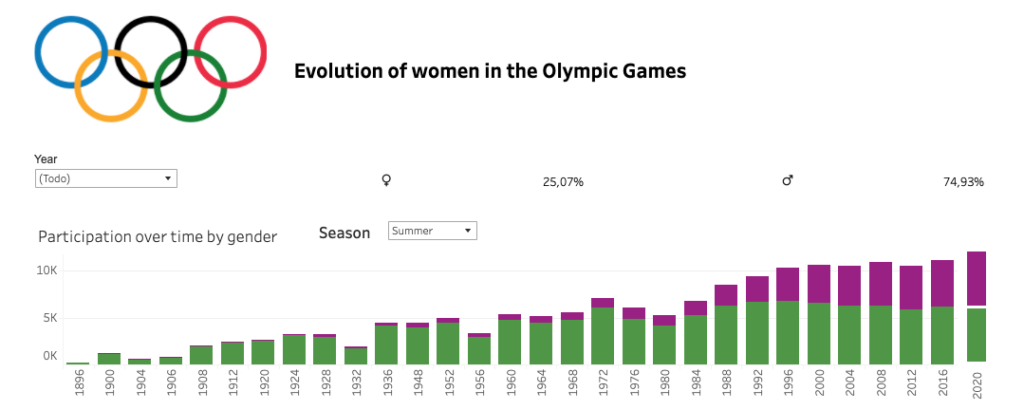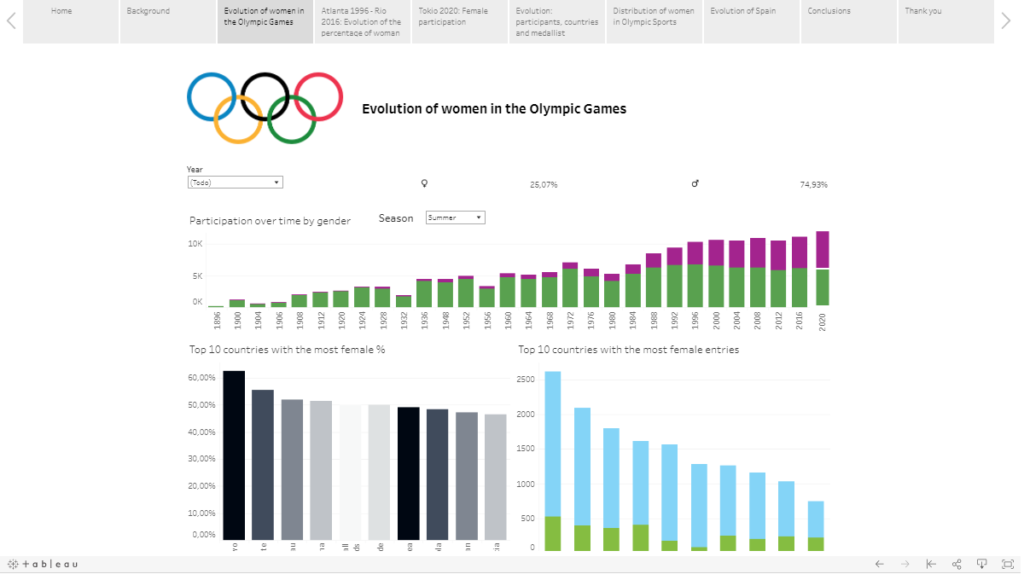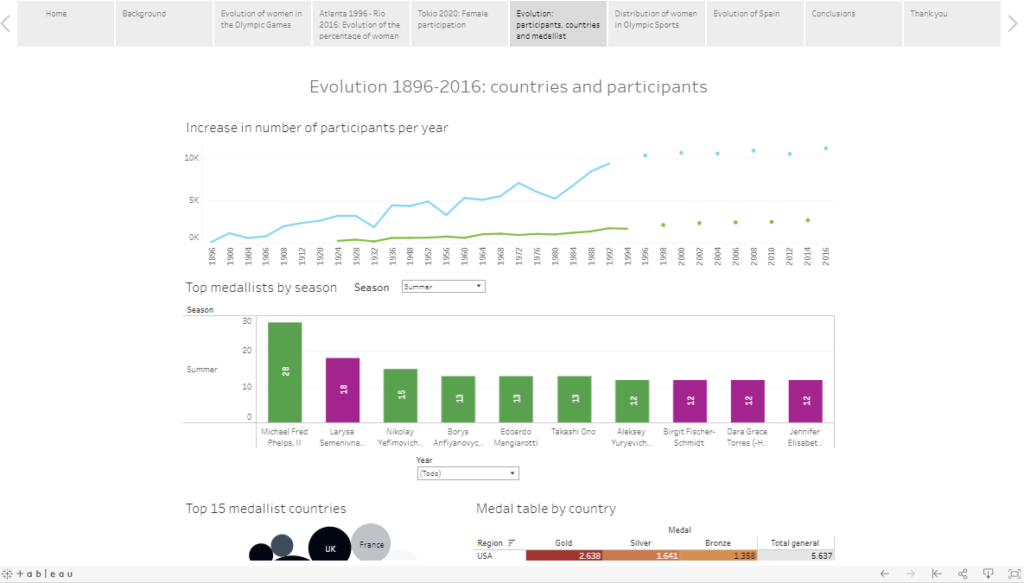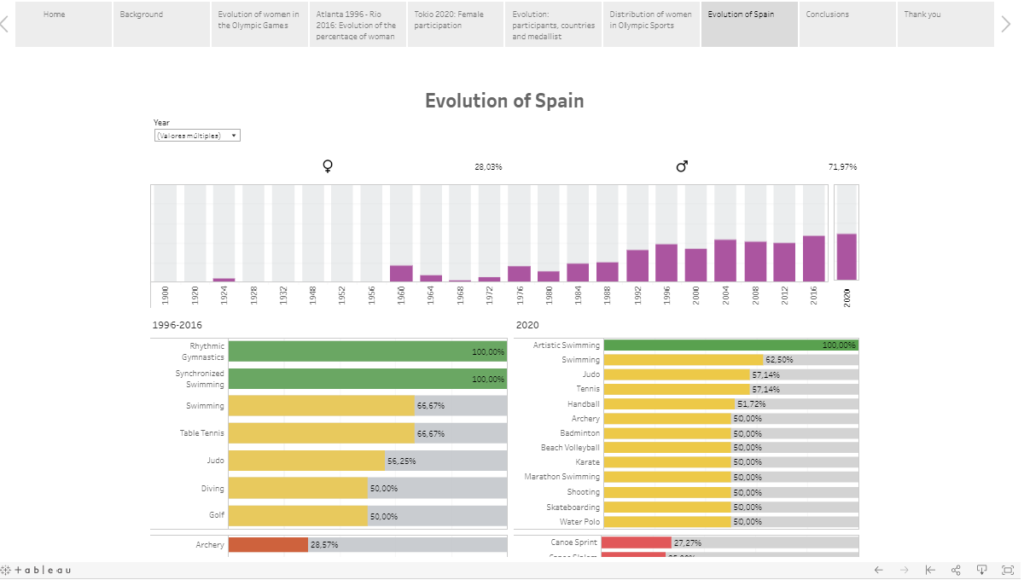
Evolution of women's participation at the Olympic Games
November 15, 2021
It is not usual to find a sports headline in our blog. Women’s increasing participation throughout the history of the Olympic Games, their impact in more and more sports disciplines, and their prominence in the medal tables of all countries can only be explained through data. After working with different datasets, we have created a dashboard that depicts this evolution.
Thanks to the tool Tableau Public (version 2021.2.1), we have been able to visualize very interesting data, such as that from 1896 games to 2021’s (Tokyo 2020), Kosovo is the country with the highest percentage of women participating in the Olympic Games out of the total number of representatives, or that the United States is the country with the highest number of female Olympians in history.
Patricia Pinar, Data Analyst and Data Visualization specialist at SNGULAR, has been working with two datasets on the Olympic Games extracted from Kaggle. After studying the datasets containing all the information about medalists, sports, regions, etc., our colleague got down to work. She decided to extract data by gender and sport discipline because she saw the potential to tell the story of the evolution of women in the games. This study on female participation in the Olympic Games over the past century and a half is an example of what can be discovered thanks to the power of well-managed and visualized data.
Patricia's work can be seen in the following dashboard, which enables you to easily browse the data displayed through highlight tables, bar charts, bubble charts or scatter diagrams.
 Access the "Analysis of the Olympic Games" dashboard
Access the "Analysis of the Olympic Games" dashboard
Some interesting data
Patricia Pinar created a simple model that joins the datasets mentioned above and features additional joins aimed at homogenizing the level of detail of data. The first one included the historical data of the Olympic Games up to Rio 2016, and the second one only contained Tokyo 2020’s results.
After extracting the information, we can visualize how the number of medals has increased in the last 24 years, a figure that is directly related to the increase in the number of sport disciplines. However, we see that since 1996, the total number of participants has barely changed, being a bit more than 10,000. In 2016, 11,179 athletes joined the Olympic Games, record participation to date. In 2021, the record was broken again, with 11,216 athletes.
The evolution is much less pronounced than in previous periods. For example, from 1988 to 1992 alone, there was an increase of about 1,000 new participants, that is to say, the same increase as in 24 years. We can see that in earlier years the curve is much more drastic. Curiously enough, we found out that in 1986 only 176 athletes took part in the Olympic Games.
The prominence of women in the Games in recent editions has grown significantly; as shown in the chart below, gender balance could be achieved soon (click on the image to access the dynamic graphics).
 Access "Women’s participation evolution"
Access "Women’s participation evolution"
The prominence of women in the different sport disciplines
After noting that in the last Olympic Games female participation reached its best rate, we wanted to delve deeper and see how it has evolved since the beginning of the first modern Olympic Games. We have identified the years when the participation of women increased significantly, as well as the sports in which they were more present; on the other hand, we have also found out that in some years women had not even participated in the games. We also wanted to show the evolution of the medals won by women in the Olympic Games and the countries with more equal participation.
Tableau enables us to tell a story, a powerful narrative combining analytics and visualization capabilities. This way, data are easier to understand for almost anyone, adapting the visualizations to the target audience, thus enabling excellent time and resource management for any activity that entails the treatment of large amounts of data. For example, we can carry out research related to human resources, health, real estate market, economy...
On the basis of the different dashboard charts we have worked on, we have drawn very significant conclusions regarding the participation of women in Games. Beyond the well-known female-only disciplines (synchronized swimming and rhythmic gymnastics), regarding Tokyo 2020 we found out 25 different sports in which there was a balance between male and female participation. You can see it in detail in the Female participation Tokyo 2020 section.
 Access "Female participation by sport"
Access "Female participation by sport"
Women in the various Olympic disciplines
From 2000 to 2016, the sport disciplines with the highest female representation are badminton, tennis, table tennis, beach volleyball, modern pentathlon, trampoline, and golf (all with a rate of around 50%), in addition to female-only disciplines (synchronized swimming, softball, and rhythmic gymnastics). The 10 disciplines in which there is a majority of men in the period mentioned above are shooting, boxing, weightlifting, rowing, equestrian, sailing, cycling, canoeing, wrestling, and baseball.
*Baseball and softball could be considered the same sport with a significant adaptation of dimensions, materials, or rules, which is why the female discipline has a different name. After careful analysis of the data, we realized that in the historical dataset both sports were shown separately, but in the Tokyo dataset both were included under a single denomination: baseball.
Equestrian, boxing, cycling, and wrestling are disciplines in which there is a majority of men. As a curiosity, we have noticed that triathlon and shooting are being incorporated as mixed events.
Between 1996 and 2004, the number of sports with a percentage of female participation above 50% was only 7, and in the period from 2008 to 2016, 12. In the last Olympic Games, the number of disciplines has increased to 27. We can see a clear increase in female participation in different sports categories.
On the other hand, between 1996 and 2004, the disciplines with a percentage of female participation below 30% were 8. In the period between Beijing 2008 and Rio 2016, there were only 3 disciplines below 30%. In Tokyo 2020, there were 5 disciplines with 30 to 40% female participation: softball, equestrian, boxing, cycling, and wrestling.
Women medalists
The most brilliant medalists in their Olympic career have a clear reference: Michael Phelps, with 28 medals in swimming. His closest rival is Larysa Latýnina, with 18 medals in artistic gymnastics. She is the most decorated woman of all times at the Games and the second most decorated athlete behind the swimmer. While Phelps' last medals were achieved in 2016, we must go back to Tokyo 1964 to find Latýnina's last. Perhaps in a few years, Simone Biles, who already has 7 Olympic medals and several records, will be the new top medalist to pick up the baton.
 Larysa Latýnina
Larysa Latýnina
Among the top 10 athletes with the highest number of Olympic medals there are three women: Jenny Thompson, Dara Grace Torres, and Birgit Fischer-Schmidt, with 12 medals each. In total, four of the top 10 medal winners are women.
The United States, Russia, and Germany lead the ranking with the most complete medal tally for both sexes. Americans lead both in terms of total number of medals (5,637) and number of golds (2,638). At Tokyo 2020, the United States (113) took the lead once again, followed by China (88) and ROC, the Russian team (71).
Spain's participation data
As for Spain’s data, it should be noted that the first time a Spanish woman participated in the Olympic Games was in 1924. That year, only two women competed, not even representing 4% of the total number of Spanish participants. It was not until 1960 that women participated in the Olympic Games again, that time with 17.23% female participation.
These data were obtained from the dashboard "Evolution of women in the Olympic Games", filtering by Spain on the "Participation over time by gender" chart. You can notice the evolution at a glance, seeing that 1992 was the turning point in terms of female participation.
Luckily, we see a clear evolution in our days. At the Tokyo 2020 Olympic Games, the participation has reached 48%, the highest percentage in the history of Spanish female participants.
Miriam Blasco won the first female Olympic medal at Barcelona 92. The first Spanish woman to win a medal did so no less than 92 years after the first Spanish man to do so. The result of hosting the Olympic Games in Spain was a significant increase in the nation’s impulse for sport. (Click on the image to access the dynamic graphics).
 Four of the top 10 Spanish medal winners are women
Four of the top 10 Spanish medal winners are women
The podium of Spanish medalists is quite balanced. Saúl Craviotto (5) and David Cal (5) lead in canoeing. Joan Llaneras in track cycling, Mireia Belmonte in swimming, Andrea Fuentes in synchronized swimming, and Arantxa Sánchez Vicario in tennis follow with 4 medals each.
All these data give us evidence of a satisfactory and significant social evolution. By structuring the figures adecuately, knowing how to arrange and cross-reference them, conclusions can be drawn to set future objectives and foster the promotion of certain values that pursue social justice. The value of data is unquestionable, but you need to know how to extract it from depth and complexity.
Our latest news
Interested in learning more about how we are constantly adapting to the new digital frontier?

Corporate news
April 22, 2025
Sngular and Fakeeh Care Group join forces to create an AI Center of Excellence in KSA

Tech Insight
April 14, 2025
Google bets on AI as a lever for hypergrowth in business

Insight
April 7, 2025
World Health Day in the AI revolution era

Tech Insight
March 19, 2025
Visualizing Software Quality with JIRA, Google Sheets, and Looker





